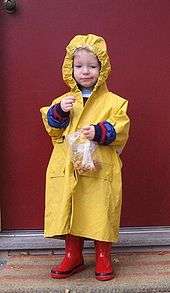Raincoat

A raincoat or slicker is a waterproof or water-resistant coat worn to protect the body from rain. The term rain jacket is sometimes used to refer to raincoats that are waist length. A rain jacket may be combined with a pair of rain pants to make a rain suit.
Modern raincoats are often constructed of breathable, waterproof fabrics such as Gore-Tex or Tyvek and coated nylons. These fabrics allow some air to pass through, allowing the garment to 'breathe' so that sweat vapour can escape. The amount of pouring rain a raincoat can handle is sometimes measured in the unit millimeters, water gauge.
History
Raincoats go back into antiquity in ancient China.[1][2] The earliest forms of Chinese constraints were made of straw and bamboo.[3][4] In Mandarin Chinese, the characters for "Suo-yi" (簑衣) mean "straw raincoat".[5] The coat was worn by farmers, fishermen and manual laborers as a protection from the sunlight, mud and rain while toiling in the dirt.[6] Straw rain capes were described in numerous poems and articles across various Chinese dynasties. By the medieval Tang and Song Dynasties, the Chinese used sedge for making rain capes as it was chosen for its smooth surface and hollow structure to repel water.[7] As earlier forms of Chinese raincoats were stiff and heavy, the Chinese eventually devised new approaches to design raincoats as time went on. One method the Chinese was to rub vegetable with silk as silk was lightweight and vegetable oil was prime material for waterproofing.[8][9] In addition, the Chinese incorporated newer types of grasses and tree leaves into their designs to create a coat that was more water resistant while concurrently being more lightweight than their earlier straw rain cape designs.[10][11]
The first modern waterproof raincoat was created following the patent by Scottish chemist Charles Macintosh in 1824 of new tarpaulin fabric, described by him as "India rubber cloth," and made by sandwiching a core of rubber softened by naphtha in two pieces of fabric.[12][13]
Styles
- Anorak, derived from traditional Inuit designs
- Cagoule, also Cagoul, Kagoule, Kagool
- Driza-Bone, Australian oiled cotton
- Gannex
- Inverness cape
- Mackintosh, rubberised cloth
- Mino, traditional Japanese raincoat made out of straw
- Oilskin
- Poncho
- Sou'wester
- Trench coat, derived from traditional raincoat
- Waxed jacket
References
- ↑ Challen, Paul (2004). Life in Ancient China. Crabtree Publishing. p. 28. ISBN 978-0778720676.
- ↑ Burns, Hilary. "From Barestems Exhibition". Basketry & Beyond.
- ↑ 北京旅游网 (May 20, 2014). "The History of Raincoats in Ancient China". Beijing Municipal Commission of Tourism Development.
- ↑ Perkins, Dorothy (1998). Encyclopedia of China: History and Culture. Routledge. p. 24. ISBN 978-1579581107.
- ↑ Zhu, Ruixi; Zhang, Bangwei; Cai, Chongbang; Wang, Zengyu (2016). A Social History of Middle-Period China: The Song, Liao, Western Xia and Jin Dynasties. Cambridge University Press (published December 22, 2016). p. 20. ISBN 978-1107167865.
- ↑ Sheth, Jagdish (2017). Genes, Climate, and Consumption Culture: Connecting the Dots. Emerald Group. ISBN 978-1787434127.
- ↑ "History of Raincoats". Going In Style. September 25, 2013.
- ↑ Siler, Wes (February 5, 2015). "The History of Rain Jacket Tech, From Intestines To Gore-Tex". Gizmodo.
- ↑ "History of Raincoats". Going In Style. September 25, 2013.
- ↑ Siler, Wes (February 5, 2015). "The History of Rain Jacket Tech, From Intestines To Gore-Tex". Gizmodo.
- ↑ "History of Raincoats". Going In Style. September 25, 2013.
- ↑ "Charles Macintosh: Chemist who invented the world-famous waterproof raincoat". The Independent. 30 December 2016.
- ↑ "History of the Raincoat". http://fashion-history.lovetoknow.com/clothing-types-styles/history-raincoat. 15 January 2017. Missing or empty
|url=(help)
External links